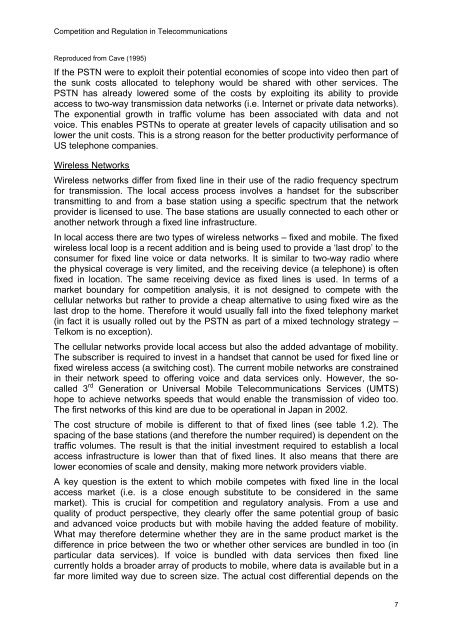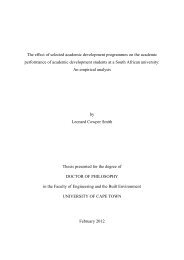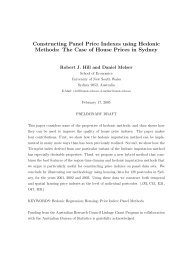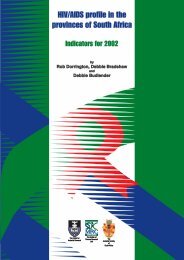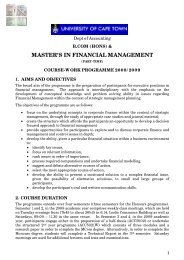Competition and Regulation in the Telecommunications Industry in ...
Competition and Regulation in the Telecommunications Industry in ...
Competition and Regulation in the Telecommunications Industry in ...
Create successful ePaper yourself
Turn your PDF publications into a flip-book with our unique Google optimized e-Paper software.
<strong>Competition</strong> <strong>and</strong> <strong>Regulation</strong> <strong>in</strong> <strong>Telecommunications</strong>Reproduced from Cave (1995)If <strong>the</strong> PSTN were to exploit <strong>the</strong>ir potential economies of scope <strong>in</strong>to video <strong>the</strong>n part of<strong>the</strong> sunk costs allocated to telephony would be shared with o<strong>the</strong>r services. ThePSTN has already lowered some of <strong>the</strong> costs by exploit<strong>in</strong>g its ability to provideaccess to two-way transmission data networks (i.e. Internet or private data networks).The exponential growth <strong>in</strong> traffic volume has been associated with data <strong>and</strong> notvoice. This enables PSTNs to operate at greater levels of capacity utilisation <strong>and</strong> solower <strong>the</strong> unit costs. This is a strong reason for <strong>the</strong> better productivity performance ofUS telephone companies.Wireless NetworksWireless networks differ from fixed l<strong>in</strong>e <strong>in</strong> <strong>the</strong>ir use of <strong>the</strong> radio frequency spectrumfor transmission. The local access process <strong>in</strong>volves a h<strong>and</strong>set for <strong>the</strong> subscribertransmitt<strong>in</strong>g to <strong>and</strong> from a base station us<strong>in</strong>g a specific spectrum that <strong>the</strong> networkprovider is licensed to use. The base stations are usually connected to each o<strong>the</strong>r orano<strong>the</strong>r network through a fixed l<strong>in</strong>e <strong>in</strong>frastructure.In local access <strong>the</strong>re are two types of wireless networks – fixed <strong>and</strong> mobile. The fixedwireless local loop is a recent addition <strong>and</strong> is be<strong>in</strong>g used to provide a ‘last drop’ to <strong>the</strong>consumer for fixed l<strong>in</strong>e voice or data networks. It is similar to two-way radio where<strong>the</strong> physical coverage is very limited, <strong>and</strong> <strong>the</strong> receiv<strong>in</strong>g device (a telephone) is oftenfixed <strong>in</strong> location. The same receiv<strong>in</strong>g device as fixed l<strong>in</strong>es is used. In terms of amarket boundary for competition analysis, it is not designed to compete with <strong>the</strong>cellular networks but ra<strong>the</strong>r to provide a cheap alternative to us<strong>in</strong>g fixed wire as <strong>the</strong>last drop to <strong>the</strong> home. Therefore it would usually fall <strong>in</strong>to <strong>the</strong> fixed telephony market(<strong>in</strong> fact it is usually rolled out by <strong>the</strong> PSTN as part of a mixed technology strategy –Telkom is no exception).The cellular networks provide local access but also <strong>the</strong> added advantage of mobility.The subscriber is required to <strong>in</strong>vest <strong>in</strong> a h<strong>and</strong>set that cannot be used for fixed l<strong>in</strong>e orfixed wireless access (a switch<strong>in</strong>g cost). The current mobile networks are constra<strong>in</strong>ed<strong>in</strong> <strong>the</strong>ir network speed to offer<strong>in</strong>g voice <strong>and</strong> data services only. However, <strong>the</strong> socalled3 rd Generation or Universal Mobile <strong>Telecommunications</strong> Services (UMTS)hope to achieve networks speeds that would enable <strong>the</strong> transmission of video too.The first networks of this k<strong>in</strong>d are due to be operational <strong>in</strong> Japan <strong>in</strong> 2002.The cost structure of mobile is different to that of fixed l<strong>in</strong>es (see table 1.2). Thespac<strong>in</strong>g of <strong>the</strong> base stations (<strong>and</strong> <strong>the</strong>refore <strong>the</strong> number required) is dependent on <strong>the</strong>traffic volumes. The result is that <strong>the</strong> <strong>in</strong>itial <strong>in</strong>vestment required to establish a localaccess <strong>in</strong>frastructure is lower than that of fixed l<strong>in</strong>es. It also means that <strong>the</strong>re arelower economies of scale <strong>and</strong> density, mak<strong>in</strong>g more network providers viable.A key question is <strong>the</strong> extent to which mobile competes with fixed l<strong>in</strong>e <strong>in</strong> <strong>the</strong> localaccess market (i.e. is a close enough substitute to be considered <strong>in</strong> <strong>the</strong> samemarket). This is crucial for competition <strong>and</strong> regulatory analysis. From a use <strong>and</strong>quality of product perspective, <strong>the</strong>y clearly offer <strong>the</strong> same potential group of basic<strong>and</strong> advanced voice products but with mobile hav<strong>in</strong>g <strong>the</strong> added feature of mobility.What may <strong>the</strong>refore determ<strong>in</strong>e whe<strong>the</strong>r <strong>the</strong>y are <strong>in</strong> <strong>the</strong> same product market is <strong>the</strong>difference <strong>in</strong> price between <strong>the</strong> two or whe<strong>the</strong>r o<strong>the</strong>r services are bundled <strong>in</strong> too (<strong>in</strong>particular data services). If voice is bundled with data services <strong>the</strong>n fixed l<strong>in</strong>ecurrently holds a broader array of products to mobile, where data is available but <strong>in</strong> afar more limited way due to screen size. The actual cost differential depends on <strong>the</strong>7


